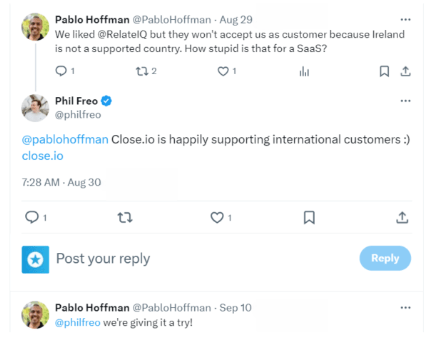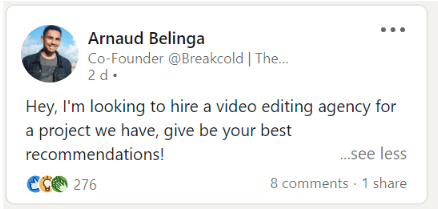How to Close More Deals for Your B2B Business with Social Media Monitoring

How to Close More Deals for Your B2B Business with Social Media Monitoring
Social media monitoring can transform your B2B sales strategy by identifying and engaging with potential clients, including competitors' unsatisfied customers, and leveraging industry trends. This article explores how to use these insights to close more deals and enhance your overall marketing efforts.
In 2024, 56% of salespeople use social media to find potential prospects. Most are doing the classic stuff: optimizing their profiles, liking, commenting, sharing relevant posts from their prospects, posting on their accounts, and DMing the accounts that comment on their posts that fit their target persona.
But what if there were an alternative way to find prospects that would have flown under your radar otherwise?
In this article, we’ll cover how to use social media monitoring to turn unsatisfied customers of your competitors into potential clients, engage with your target market even when they don’t mention your company, analyze your social media monitoring ROI, and other ways to integrate monitoring with your current strategies.
Ready to find new hot leads? Let’s dive in!
What is Social Media Monitoring?
Have you ever wondered how companies like Wendy's are always present under social media posts that talk about them, even when not directly mentioned? That’s the power of social media monitoring.
Social media monitoring tracks and analyzes online conversations on major social media platforms. There are a lot of things you can track :
- Keywords and hashtags relevant to your brand and your industry
- The mentions of your brand
- Your competitor’s social profile activity and mentions
- The sentiment behind social media posts
This practice is incredibly helpful in discovering emerging industry trends and customer behavior shifts. Monitoring social media can help you address customers' complaints faster, identify ways to improve your pages, and analyze your competition.
Let’s focus on the last part, specifically your competition's unsatisfied customers.
1. Identify Unsatisfied Customers
You’ve probably seen this kind of post often online:
You can stumble upon an unsatisfied customer by following your competitors' social profiles and reviewing their comments whenever they post something new.
However, this manual process is extremely time-consuming and inefficient. Fortunately, social media monitoring tools can help speed up that process.
Social media monitoring tools allow you to track everything that’s communicated about any brand, topic, or industry in minutes.
The setup is straightforward:
- Create an alert with your competitor's brand name and branded hashtags
- Receive all the mentions of their brand on social media
- Analyze the sentiment of each publication using built-in sentiment analysis features
- Reach out to customers with negative sentiment towards your competitor
Other customer identification methods include monitoring review sites, industry forums, and news sites.
Once you’ve identified an unsatisfied customer, how do you engage with them to maximize your chances of converting them into one of your clients?
How to Engage with Unsatisfied Customers
Personalized outreach is the most effective way to get your message out there. When reaching out to someone, remember that the person is already familiar with the kind of product or service you’re selling. Take note of the specific issues or problems mentioned in their comment or post.
In your response or DM, showcase how your product or service can help address their challenges compared to what your competitor is offering. You can offer a discount or a free trial to entice them to try your solution.
If they haven’t responded to your previous message, engage with one of their recent posts or comments to remind them of your conversation. Be careful not to overdo it. Otherwise, you might come across as too pushy.
Close used this strategy to win a $585/month client from one of their main competitors, RelateIQ. When Salesforce acquired RelateIQ a few years ago, it canceled many of its international customers' contracts.
One of these customers complained about the change on Twitter. This tweet would have gone unnoticed by Close in most cases, but since they had an alert they were monitoring about RelateIQ, they could jump into the conversation and position Close as an alternative.
It worked wonders. One single tweet generated an additional $585 MRR for the company, although it took less than 5 minutes to identify and answer the tweet. It’s a pretty good ROI for a CRM company that can spend thousands of dollars to acquire one client, right?
Answer Questions About Your Industry
Another way to put your foot in the door and be considered one of the main options for potential prospects is to answer questions related to your industry. You can provide expert advice on best practices, where you see your industry going, the challenges, and the trends. It’ll help make your brand top-of-mind when someone needs to buy your product or service.
Imagine you’re an agency selling video editing services. You’re monitoring all the terms related to your industry and found this post on LinkedIn that no one has commented on yet:
Jumping in to answer this question positions you as an expert and increases your visibility to other brands that might have similar needs. In this example, a good answer would look like this:
“Yvideo could be a great fit. We’ve produced over 1500 short and long-form videos for B2B SaaS companies like Z and Y, amassing a combined 20M° views. What kind of video editing do you need exactly? We’d love to hear more about your needs and see how we can help.“
The answer is direct and invites them to switch the conversation in DM, so your salesperson can qualify the prospect before scheduling a call.
This is one of our strategies to find new clients at Mention. Our social media specialist spends ~15 minutes daily finding posts and comments that we could hop on to promote our company. This promotes us to the creator of the post and his audience, therefore enhancing our reach even more!
Analyze Your Results
Engaging with potential customers online is great, but knowing the exact ROI you’ve generated from it is even better!
Track Interactions
Keep a file of all your interactions with potential clients using social media monitoring, along with the time spent on each interaction (or in total). While most interactions won’t directly lead to conversions, we advise you to check your database of recent clients once every month or two months to see which brands ended up becoming clients.
Most customers won’t directly tell you that they’ve signed up because of a tweet or comment you’ve made. You’ll have to analyze your data to gather this information.
Calculate ROI
To calculate the ROI of your social selling activity with social monitoring, divide the sales you’ve generated by the cost of human labor (hours x hourly rate) + the cost of the tool you’re using.
With that formula, you’ll easily be able to track direct revenue from your activity on social media from social media monitoring! Using that information, you can decide whether to expand your social selling activities, maintain your current level of engagement, or reduce your involvement.
Remember that your ROI result doesn’t include any other monitoring uses (like positioning yourself on new industry trends, listening to your market to adapt your product, enhancing customer support, etc.…).
These benefits are more complex to quantify but can contribute much to your company’s growth.
Integrate Social Media Monitoring with Other Business Strategies
While we focused this article on social selling using social media monitoring, monitoring can be applied in many other ways. Here are some ideas to integrate social media monitoring with the other marketing strategies you’ve in place:
Content Strategy
Social media monitoring can help you find new content ideas by analyzing the trends in your market. This will help you create relevant content that your target audience is searching for. By identifying the central pain points customers and potential leads are bringing up online, you can create new content dedicated to solving those problems.
For instance, if you're in the cloud services industry, you might notice increased discussions around cloud compliance. This could prompt you to create content addressing specific compliance challenges, such as a guide on meeting GDPR requirements with cloud solutions, helping you attract businesses actively seeking this information.
Monitoring influencers in your industry can be a great way to know what topics are gaining the most heat right now.
When creating a blog, you can also identify content gaps in your current content strategy by monitoring your competitors and addressing specific requests that have yet to be addressed.
If you become one of the main sources of content to educate prospects, you’ll likely be the one they end up doing business with.
Customer Service
Use monitoring to find complaints about your brand that you wouldn’t have otherwise. 71% of customers believe that a quick answer to a complaint increases their customer experience. A good experience with support can turn an unsatisfied customer into an advocate of your brand.
Another way to improve customer service is to identify the questions that are asked the most often online and update your FAQ to answer them on your website. This will reduce the number of clients who need to contact support.
Crisis Management
An early detection of a crisis is critical to reducing its impact on your brand. By tracking your brand mentions, you can be alerted when there’s a spike in mentions of your brand online. Sentiment analysis will then tell you whether the sentiment towards your brand is negative or positive and identify the public perception of the crisis you’re facing.
Social media monitoring will help you quickly answer negative comments and manage the situation as smoothly as possible.
Harness Social Media Monitoring Capabilities To Drive B2B Sales
Now that you know what social media monitoring is, how to use it to close more clients for your B2B business, and other use cases, it’s time to implement it!
Ready to take your B2B sales to the next level? Start integrating social media monitoring into your marketing strategy now, and watch your social sales grow!




